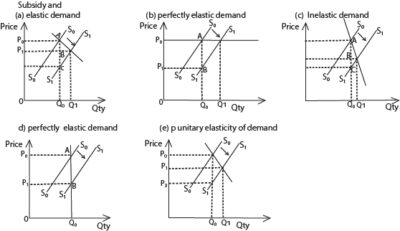
Apply the concept of price elasticity of demand to subsidies.

Its applicability depends on the degree of elasticity and can be explained in terms of how the benefits from subsidy are shared between the producer and the consumer.
Note: subsidies shift the supply curves to the right
(i) A subsidy and elastic demand
In this case a subsidy benefits both the producer and the consumer. However, the producer benefits more than the consumer as illustrated in fig. (a) above
The total subsidy is AC. AB belongs to the consumer and BC to the producer which is greater than AB. The producer increases his production from OQ0 to OQ1.
(ii) Subsidy and perfectly elastic demand
In this case, a subsidy benefit only the producer as illustrated in fig (b)
The total subsidy AB goes to the producer as he increases his production for OQ0 to OQ1.
(iii) Subsidy and inelastic demand
Here the subsidy benefits the consumer more than the producer as illustrated in fig. (c) above.
AC is the total subsidy. AB goes to the consumer and BC to the producer which is less than AB. However a producer increases production from OQ0 to OQ1 but with a smaller margin compared to a fall in price from OP0 to OP1.
(iv) A subsidy and perfectly inelastic demand
In this case the whole subsidy benefits the consumer in form of reduced prices as illustrated in fig. (d) above.
AB is the total subsidy which wholly goes to the consumer. The producer’s production remains constant. i.e. OQ0.
(v) A subsidy and unitary elasticity of demand.
In this case the subsidy is shared equally between the consumer and the producer as illustrated in fig. (e) above
The total subsidy is AC. AB benefits the consumer and BC the producer. However, the increase in the production fromOQ0 to OQ1 is equally followed by a decrease in price from OP0 toOP1.

